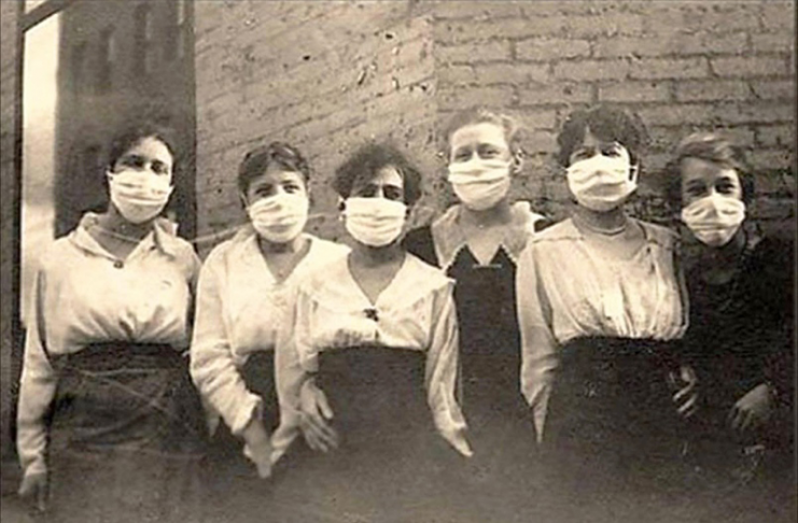…more than 6300 deaths were recorded
…social distancing, wearing of masks, home remedies return with COVID-19
By Alva Solomon
THESE days, before Guyanese leave the confines of their homes, they pull on their masks; the authorities are appealing almost daily for persons to practice social distancing; pictures of home remedies such as lemon-grass tea and ginger are popping up frequently on Facebook.
Rewind way back to the months between 1918-March to 1919.
The home remedies, the masks and messages urging no more than 10 persons to gather were on the front burner back then.
The disease was the Influenza, known as the Spanish Flu, a pandemic which killed approximately 500 million people. It left many homes without parents and a wave of poverty beyond economic proportions in its wake.According to the US Center for Disease Control, the flu is linked to an H1N1 virus.The name ‘Spanish Flu’ is often criticised for its link to Spain which recorded cases which originated in France during the war.
Spain held neutral ground during the war and as such reported on the flu while other countries were hesitant to do so since it impacted their populations heavily.
Today, scientists and global health experts are cautioning the world that the Coronavirus (COVID-19) should be taken seriously and any plans to reopen world economies soon should be re-considered.
Their advice may be linked to the lessons learned from the Spanish Flu. The influenza came in three ‘waves’. The first occurred around March 1918, but in August that year, the second wave proved to be the most devastating, killing thousands.
During the latter years of the first World War, which ran from 1914 to 1918, the flu emerged in parts of Europe and quickly spread throughout the world. The flu crept into the Caribbean around October 1918 and resulted in the deaths of approximately 100,000 persons, although stricter record keeping could have seen that number climbing.
The Spanish Flu in Guyana
According to British Professor, David Killingray , along with Belize, Guyana was severely affected by the pandemic.
Writing in “The Society for the Social History of Medicine” journal of 1994, Killingray said that a mild outbreak was first observed in Guyana , then British Guiana, around July of 1918.It most likely was brought on a ship from Trinidad and Tobago.
After its arrival, many cases were recorded at communities on the East Bank and West Bank of Demerara. At the time, there were a few deaths.
The population at the time stood at 310,000. Of this number, 6,378 deaths were recorded between the months of December 1918 and February 1919, but the estimated number of deaths were as much as 12,000, since record keeping , especially in outlying and Hinterland communities, was so difficult that putting ink to paper was a challenge, more so updating the figures.
Later that year, around December, a second, devastating wave of the flu swept through the country. The flu emerged on the coastland at epidemic proportions, with “extreme rapidity almost simultaneously”, wreaking havoc in communities between Skeldon and Anna Regina.
The railway system, which was a preferred means of transportation at the time, as well as boats and village canoes, speeded up the spread of the pandemic. Crowded housing in Georgetown, Anna Regina and New Amsterdam, as well as the packed, ill-ventilated huts on the sugar plantations, were the perfect breeding ground for the influenza.
“Plantation labourers fleeing the estates helped to spread the virus. By the fourth week of December, the epidemic had reached inland to the Canje River, and, by early January, the Upper Berbice River area, and also up the Essequibo and the Potaro rivers to Tumatumari. In the next few weeks of the new year those places which the virus reached last were among the hardest hit. In most districts, the infection lasted for about one month; the pandemic declined in February and by March 1919, only a few isolated cases were recorded,” Professor Killingray noted.
He said that the flu notably affected East Indian labour camps and villages, and the highest numbers of mortality were recorded there.
Indigenous population impacted heavily
It was noted that Guyana’s indigenous communities felt the brunt of the Spanish flu.
In his diary, the Jesuit missionary, C. Carey-Elwes recorded that some of his Indo-Guyanese mission workers had gone to Georgetown which had become ‘a regular death trap’.
When they fell ill, they left the capital and started up the Essequibo in their boat. A few days later, balata tappers found their bodies on the river bank where all but one had died in their hammocks.
At Tumatumari in Region Eight, the number of deaths were so high that no one was left standing to bury the dead, with an average of three deaths per day recorded.
More males than females
According to Professor Killingray, the Registrar General recorded that 3842 East Indian Guyanese died from influenza and 2190 from pneumonia and bronchial complaints. He said that more males than females died. It was noted, too, that the most vulnerable section of the population was the 20-30 age group.
Said Professor Killingray, “In his official report, the Acting Surgeon General concluded that ‘this epidemic of influenza has been the most severe visitation of disease within the memory of any colonist, the almost universal prevalence and high mortality have caused untold suffering.”
He said that the impact was so heavy that three hospitals on the coastland at Georgetown, New Amsterdam and Suddie were overwhelmed with patients. In addition, records indicate that one-third of all medical staff were down with the flu.
“In the Public Hospital, Georgetown, where many cases of a severe type were being treated, a visit to an influenza ward was most distressing: frequent and noisy coughing, combined with the ravings of delirious patients created such a din that it was difficult to make oneself heard. Added to this, the attempts of the delirious to leave their beds or even to fall out of them if not closely watched, made the work of the nurses, whose members had been sadly depleted by the disease, very anxious, trying and laborious,” said Professor Killingray.
Emergence of a vaccine and Emergency measures
Among the measures put in place by the authorities, at the time, were the banning of wakes and such public gatherings here in Guyana. A group of no more than 10 persons were allowed. In addition, the widespread wearing of face masks was urged by the health authorities.
He said that official attempts to prevent the spread of the virus, once it had entered an area, ranged from leaflets with advice on basic hygiene and ideas about how to avoid or cure the disease, restrictions on the movement and gathering of people, and the isolation of those who were infected.
It was noted that in late 1918, the Government Bacteriological Department in Georgetown produced its own vaccine which was made available for prophylactic inoculations.
By the second week of January, 1500 doses had been used, mainly on plantation workers but without its desired effect.
By this time, a number of local remedies came to the fore and they included the gulping of rum and honey, stimulants and creosote; digesting 30 grains of citrate of potash and 30 grains of bicarbonate of soda. As is the case today, the fumigation of buildings and a daily cold bath, and a mild laxative were among the remedies.
As has been the case today with the COVID-19, business for drug stores soared with many offering various services to customers.
While the period 1918-1919 contrasts sharply to today’s 2019-2020 period of the coronavirus, the similarities in measures cannot go unnoticed.
COVID-19 vaccine
While no vaccine has been developed for the deadly coronavirus, clinical tests on the development of vaccines have begun in the more advanced countries including the United Kingdom.
According to Professor Killingray’s report, a deep sense of humanity emerged as a notable positive from the Spanish Flu. Today, with Youtube , Facebook and social media apps, that message of humanity circulates 24-7, with the advice to observe social distancing , wear a mask and wash one’s hands being the key messages.
Click here to read Professor David Killingray’s article “The Influenza Pandemic of 1918-1919 in the British Caribbean”.




.jpg)









